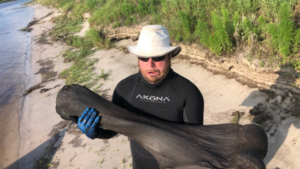NPR’s Michel Martin visits the National Memorial for Peace and Justice, founded by attorney Bryan Stevenson, to memorialize the victims of lynchings that took place in the U.S. after the Civil War.
MICHEL MARTIN, HOST:
And finally, today, we’re just back from Montgomery, Ala., and one of the issues we wanted to talk about with the people there was their history and how they want to talk about it. It’s significant to Montgomery. The city features dozens of monuments to the Confederacy, and it’s in a state where local governments can face stiff fines if they remove or alter such iconography. That’s part of what led us to the National Memorial for Peace and Justice, a site dedicated to the victims of lynching which was founded by attorney Bryan Stevenson. Its presence is a physical manifestation of a debate taking shape across the country about what should be acknowledged and memorialized and how, so we went to see it for ourselves.
Bryan Stevenson, thank you so much for meeting us here at this special place, which was, I take it, sort of the fruit of your imagination.
BRYAN STEVENSON: Yeah.
MARTIN: It’s a remarkable experience just walking onto the grounds. What did you envision when you first conceived of this place?
STEVENSON: You know, I had been to South Africa. And I’d gone to the apartheid museum there. And it really shook me because it was such a powerful orientation to the harm, the tragedy, the suffering that apartheid created. And then I went to the Holocaust memorial in Berlin and was also struck by that because it seemed to really force you to reckon with the horrors of the Holocaust. I just thought, we don’t have places like that in America. And I really wanted to create a space that felt sacred and sober and necessary if we’re going to begin to understand our history.
MARTIN: Why is lynching the focus of this particular space that we’re in now?
STEVENSON: Yeah. Well, I think that’s a really important question. I think we have not appreciated the role of racial terror and violence against African Americans. And for me, it’s a central topic because we pride ourselves on being a democracy governed by the rule of law, and yet we tolerated decades of lawlessness. This was all terrorism. And I don’t think there has been acknowledgment of it. The communities where this violence persisted had been silent about it. And so lifting this up was really important. But we wanted to situate it with the larger narrative. And so while the focus is on lynching, we start the journey through the National Memorial on this path with a sculpture about slavery.
MARTIN: Let’s go see it.
(SOUNDBITE OF FOOTSTEPS)
MARTIN: A path leads to a statue depicting six enslaved people, including a child, everyone in chains. The scene is clear about the brutality of slavery, but there’s also hope. A mother cradles a baby in one arm and stretches her hand towards the man, likely her spouse, who’s just beyond her reach.
STEVENSON: In addition to having to give life, which is what this figure represents, holding this infant, there is this need to just kind of support and manage and stay human in the face of so much inhumanity. And I love that figure more than anything else because she is holding on to life, to love, to hope and trying to give comfort and support to those who are around her.
MARTIN: The venue is sprawling and stunning, with beautiful greenery and hills that allow for views of the city of Montgomery. At the top of one hill is a pavilion which houses large columns that hang from the ceiling.
STEVENSON: So each of these are what we call monuments. They are 6 feet. They’re made out of courten steel. And we use that material because courten steel, when it’s fabricated, is silver. But when you put it in the environment, it oxidizes, and it turns to a kind of brown, to kind of a red brown, a dark brown, a medium brown. They’re not all the same complexion. And we chose 6 feet because we want it to represent the human form. And these brown monuments represent something that has the feeling of the human body. We organize them by county because the jurisdiction for law and our country is typically organized around a county. And then we list the names of all of the documented victims of lynching in that county. And so what you see when you walk in are the names of people and the dates when the lynching events took place. And some, like Burke County, Ga., you see three names, Pike County, Ga., three names, Wilcox County, Ala., four names. And you become acculturated to the variation. You’ll see monuments as we walk through where there are 20 names or 30 names.
MARTIN: You know, when I first came here and I just randomly stopped in front of the pillar that was where my grandfather was raised, and I almost, like, I mean, I just randomly stopped there. And I looked up. And it was Danville, Va.
STEVENSON: Yeah.
MARTIN: And he was the child of a Black woman and a white man. And as a teenager – this is the family history – he came home to see this man beating his mother. Obviously, a teenage boy is not going to tolerate that. And the story goes that he said to this man, his father, if you touch my mother again, I’ll kill you. And the men of the community came to him that night and said, you have to leave. They’re going to kill you. And they gathered whatever resources they had to put him on a train that night to get him out of town. And that’s how he ended up in Philadelphia, which is where he spent the rest of his his life. And sure enough, when I came here, that’s the pillar that I happened to stand under, that town. And I couldn’t believe it.
STEVENSON: It’s such – I mean, so many people have that experience just like you. They come here, they see a county. They think, oh, my God, that’s where my grandparents are from. And it does bring to mind the weight of this history.
MARTIN: This is one pillar we’re standing under now that I want to point out. And the fact that so many women – I think this is one of the things that I think will be a shock to some people is how many women’s names are on these pillars, how many women were subjected to this as well as men.
STEVENSON: Absolutely.
MARTIN: As the monuments hang overhead, the horror, the sweep of lynching becomes very real. Stevenson says these acts were not just about punishing perceived wrongdoing, but about policing Black conduct, thought and aspiration in every way.
STEVENSON: Racial terror lynchings were utilized to not just punish people for perceived criminal behavior, although most of the time the people had not done the things they were accused of, but they were also used to block Black achievement. People who organized other Black people to try to vote, people who just criticized racial inequality, people who tried to organize better labor conditions would often be the targets of this violence and lynching. And then, of course, if someone complained about the lynching violence, they would be targeted, too. They’d be killed, too.
MARTIN: While in Montgomery, we met someone who has a personal connection to this painful history.
JOSEPHINE BOLLING MCCALL: I am Josephine Bolling McCall. I am the youngest daughter of Elmore Bolling. And this is my home.
MARTIN: She told us that her father had become a successful businessman in Lowndes County, Ala. And he was murdered because of that and the prominent role he played in trying to lift the economic fortunes of his community. Mrs. Bolling McCall spent years learning about the details of his murder and that of others. And one thing she discovered is that lynchings took place in many forms. They were not just hangings. Her father was shot to death. But apart from that horrible end to his life, Mrs. Bolling McCall told us she remembered him as a loving and doting dad.
BOLLING MCCALL: When I turned 5 in July, the year that he was killed, he brought me a doll. And the doll was as tall as I. And, of course, back then, only white dolls were in the South. So I had this tall doll. And we took a picture in front of our store between the service station’s gas tanks. My dad holding one hand of the and doll and I was holding the other hand.
MARTIN: Oh, that must have been a special birthday.
BOLLING MCCALL: That was a very special birthday and the last birthday with him.
MARTIN: Oh, I’m sorry. Do you remember – I mean, you were so little – do you remember when he was killed?
BOLLING MCCALL: I was at the store, as was my mother and my brother, Dee (ph), my brother Morris (ph). And we were there. We heard the shots. And he was killed less than 150 yards from us at the fork in the road that turned to go to our home.
MARTIN: That’s horrifying.
BOLLING MCCALL: So one of the men who was riding with him came up and told us that he had been shot. So my mom said, get the gun. He said, no use. He’s dead. So my mom got the gun anyway. And we walked from the store down to the scene of the murder. And I actually saw my father lying in the ditch with his eyes open.
MARTIN: That’s horrible. That is horrible. Do you remember growing up what you thought or what you were told about all this? Were you told anything?
BOLLING MCCALL: Not really. I was sort of shielded. The biggest thing that I heard over the years was what a fine man my father was. As the newspaper said, he had an excellent reputation in the community. That’s what I lived off of. If I said my name was Josephine Bolling anywhere I went, people will say, oh, you’re Elmore Bolling’s daughter. So I lived off his legacy.
MARTIN: But Mrs. Bolling McCall, a trained psychologist, says that mental anguish is also part of that legacy.
BOLLING MCCALL: So my third oldest brother was the one who was at the scene with me. And he started disrobing my dad and wanted to take his boots out because of the old wives tale that a person can’t get into heaven with his boots on. So he actually suffered more than the rest of us, I believe. He saw us at school. He was the big brother that made sure we got to school every day. So it had a devastating effect on all of us not having counseling.
MARTIN: But despite that pain, she says having her father’s story in the Peace and Justice Memorial feels like vindication.
BOLLING MCCALL: My biggest thing was that I wanted the world to know that my dad had been lynched just because of his prosperity, had not done anything wrong. He was not accused of a crime. He had not committed a crime. And all he did was work to help his family. So when Mr. Stevenson came out with the National Memorial for Peace and Justice, I was thrilled because he was another means of my father’s story getting to the public.
MARTIN: And that story is being shared by the hundreds of thousands. The memorial is a huge draw for tourism, one of the top attractions in the entire state, according to Montgomery’s mayor, Steven Reed. Still, Stevenson knows this history is not easy to digest.
STEVENSON: We know that this is a kind of a tough experience for people. And so when you get down to this corridor at the end of the third quarter, we wanted people to have a chance to just kind of process a little bit.
MARTIN: So they have a place to sit down.
STEVENSON: They have a place to sit down. There is a water wall on the side. And the water wall is dedicated to the thousands of African Americans who were lynched who we cannot document, whose names we’ll never know.
MARTIN: That was attorney Bryan Stevenson, founder and executive director of the Equal Justice Initiative, which runs the National Memorial for Peace and Justice in Montgomery, Ala. We also heard from Josephine Bolling McCall.
Copyright © 2022 NPR. All rights reserved. Visit our website terms of use and permissions pages at www.npr.org for further information.




